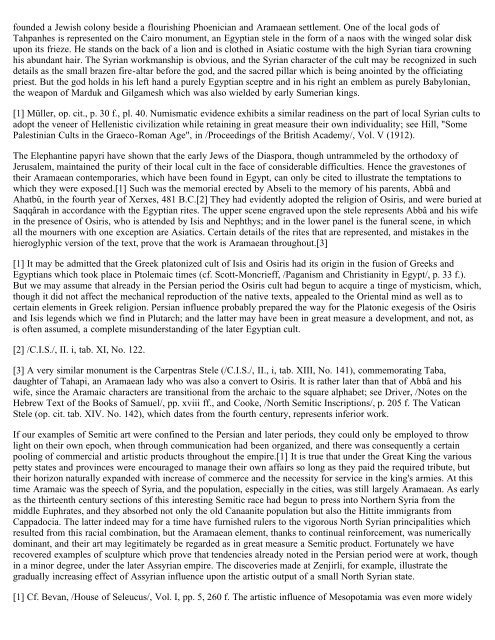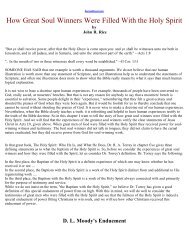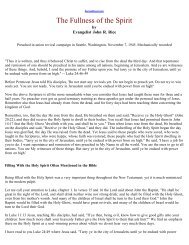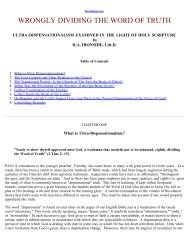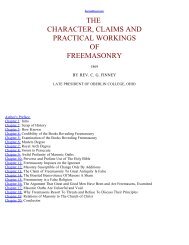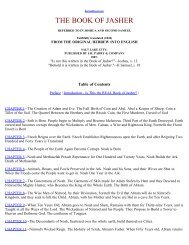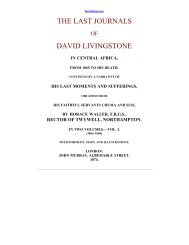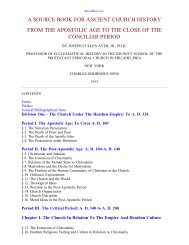Legends of Babylon and Egypt in Relation to Hebrew Tradition.pdf
Legends of Babylon and Egypt in Relation to Hebrew Tradition.pdf
Legends of Babylon and Egypt in Relation to Hebrew Tradition.pdf
You also want an ePaper? Increase the reach of your titles
YUMPU automatically turns print PDFs into web optimized ePapers that Google loves.
founded a Jewish colony beside a flourish<strong>in</strong>g Phoenician <strong>and</strong> Aramaean settlement. One <strong>of</strong> the local gods <strong>of</strong><br />
Tahpanhes is represented on the Cairo monument, an <strong>Egypt</strong>ian stele <strong>in</strong> the form <strong>of</strong> a naos with the w<strong>in</strong>ged solar disk<br />
upon its frieze. He st<strong>and</strong>s on the back <strong>of</strong> a lion <strong>and</strong> is clothed <strong>in</strong> Asiatic costume with the high Syrian tiara crown<strong>in</strong>g<br />
his abundant hair. The Syrian workmanship is obvious, <strong>and</strong> the Syrian character <strong>of</strong> the cult may be recognized <strong>in</strong> such<br />
details as the small brazen fire-altar before the god, <strong>and</strong> the sacred pillar which is be<strong>in</strong>g ano<strong>in</strong>ted by the <strong>of</strong>ficiat<strong>in</strong>g<br />
priest. But the god holds <strong>in</strong> his left h<strong>and</strong> a purely <strong>Egypt</strong>ian sceptre <strong>and</strong> <strong>in</strong> his right an emblem as purely <strong>Babylon</strong>ian,<br />
the weapon <strong>of</strong> Marduk <strong>and</strong> Gilgamesh which was also wielded by early Sumerian k<strong>in</strong>gs.<br />
[1] Müller, op. cit., p. 30 f., pl. 40. Numismatic evidence exhibits a similar read<strong>in</strong>ess on the part <strong>of</strong> local Syrian cults <strong>to</strong><br />
adopt the veneer <strong>of</strong> Hellenistic civilization while reta<strong>in</strong><strong>in</strong>g <strong>in</strong> great measure their own <strong>in</strong>dividuality; see Hill, "Some<br />
Palest<strong>in</strong>ian Cults <strong>in</strong> the Graeco-Roman Age", <strong>in</strong> /Proceed<strong>in</strong>gs <strong>of</strong> the British Academy/, Vol. V (1912).<br />
The Elephant<strong>in</strong>e papyri have shown that the early Jews <strong>of</strong> the Diaspora, though untrammeled by the orthodoxy <strong>of</strong><br />
Jerusalem, ma<strong>in</strong>ta<strong>in</strong>ed the purity <strong>of</strong> their local cult <strong>in</strong> the face <strong>of</strong> considerable difficulties. Hence the graves<strong>to</strong>nes <strong>of</strong><br />
their Aramaean contemporaries, which have been found <strong>in</strong> <strong>Egypt</strong>, can only be cited <strong>to</strong> illustrate the temptations <strong>to</strong><br />
which they were exposed.[1] Such was the memorial erected by Abseli <strong>to</strong> the memory <strong>of</strong> his parents, Abbâ <strong>and</strong><br />
Ahatbû, <strong>in</strong> the fourth year <strong>of</strong> Xerxes, 481 B.C.[2] They had evidently adopted the religion <strong>of</strong> Osiris, <strong>and</strong> were buried at<br />
Saqqârah <strong>in</strong> accordance with the <strong>Egypt</strong>ian rites. The upper scene engraved upon the stele represents Abbâ <strong>and</strong> his wife<br />
<strong>in</strong> the presence <strong>of</strong> Osiris, who is attended by Isis <strong>and</strong> Nephthys; <strong>and</strong> <strong>in</strong> the lower panel is the funeral scene, <strong>in</strong> which<br />
all the mourners with one exception are Asiatics. Certa<strong>in</strong> details <strong>of</strong> the rites that are represented, <strong>and</strong> mistakes <strong>in</strong> the<br />
hieroglyphic version <strong>of</strong> the text, prove that the work is Aramaean throughout.[3]<br />
[1] It may be admitted that the Greek pla<strong>to</strong>nized cult <strong>of</strong> Isis <strong>and</strong> Osiris had its orig<strong>in</strong> <strong>in</strong> the fusion <strong>of</strong> Greeks <strong>and</strong><br />
<strong>Egypt</strong>ians which <strong>to</strong>ok place <strong>in</strong> P<strong>to</strong>lemaic times (cf. Scott-Moncrieff, /Paganism <strong>and</strong> Christianity <strong>in</strong> <strong>Egypt</strong>/, p. 33 f.).<br />
But we may assume that already <strong>in</strong> the Persian period the Osiris cult had begun <strong>to</strong> acquire a t<strong>in</strong>ge <strong>of</strong> mysticism, which,<br />
though it did not affect the mechanical reproduction <strong>of</strong> the native texts, appealed <strong>to</strong> the Oriental m<strong>in</strong>d as well as <strong>to</strong><br />
certa<strong>in</strong> elements <strong>in</strong> Greek religion. Persian <strong>in</strong>fluence probably prepared the way for the Pla<strong>to</strong>nic exegesis <strong>of</strong> the Osiris<br />
<strong>and</strong> Isis legends which we f<strong>in</strong>d <strong>in</strong> Plutarch; <strong>and</strong> the latter may have been <strong>in</strong> great measure a development, <strong>and</strong> not, as<br />
is <strong>of</strong>ten assumed, a complete misunderst<strong>and</strong><strong>in</strong>g <strong>of</strong> the later <strong>Egypt</strong>ian cult.<br />
[2] /C.I.S./, II. i, tab. XI, No. 122.<br />
[3] A very similar monument is the Carpentras Stele (/C.I.S./, II., i, tab. XIII, No. 141), commemorat<strong>in</strong>g Taba,<br />
daughter <strong>of</strong> Tahapi, an Aramaean lady who was also a convert <strong>to</strong> Osiris. It is rather later than that <strong>of</strong> Abbâ <strong>and</strong> his<br />
wife, s<strong>in</strong>ce the Aramaic characters are transitional from the archaic <strong>to</strong> the square alphabet; see Driver, /Notes on the<br />
<strong>Hebrew</strong> Text <strong>of</strong> the Books <strong>of</strong> Samuel/, pp. xviii ff., <strong>and</strong> Cooke, /North Semitic Inscriptions/, p. 205 f. The Vatican<br />
Stele (op. cit. tab. XIV. No. 142), which dates from the fourth century, represents <strong>in</strong>ferior work.<br />
If our examples <strong>of</strong> Semitic art were conf<strong>in</strong>ed <strong>to</strong> the Persian <strong>and</strong> later periods, they could only be employed <strong>to</strong> throw<br />
light on their own epoch, when through communication had been organized, <strong>and</strong> there was consequently a certa<strong>in</strong><br />
pool<strong>in</strong>g <strong>of</strong> commercial <strong>and</strong> artistic products throughout the empire.[1] It is true that under the Great K<strong>in</strong>g the various<br />
petty states <strong>and</strong> prov<strong>in</strong>ces were encouraged <strong>to</strong> manage their own affairs so long as they paid the required tribute, but<br />
their horizon naturally exp<strong>and</strong>ed with <strong>in</strong>crease <strong>of</strong> commerce <strong>and</strong> the necessity for service <strong>in</strong> the k<strong>in</strong>g's armies. At this<br />
time Aramaic was the speech <strong>of</strong> Syria, <strong>and</strong> the population, especially <strong>in</strong> the cities, was still largely Aramaean. As early<br />
as the thirteenth century sections <strong>of</strong> this <strong>in</strong>terest<strong>in</strong>g Semitic race had begun <strong>to</strong> press <strong>in</strong><strong>to</strong> Northern Syria from the<br />
middle Euphrates, <strong>and</strong> they absorbed not only the old Canaanite population but also the Hittite immigrants from<br />
Cappadocia. The latter <strong>in</strong>deed may for a time have furnished rulers <strong>to</strong> the vigorous North Syrian pr<strong>in</strong>cipalities which<br />
resulted from this racial comb<strong>in</strong>ation, but the Aramaean element, thanks <strong>to</strong> cont<strong>in</strong>ual re<strong>in</strong>forcement, was numerically<br />
dom<strong>in</strong>ant, <strong>and</strong> their art may legitimately be regarded as <strong>in</strong> great measure a Semitic product. Fortunately we have<br />
recovered examples <strong>of</strong> sculpture which prove that tendencies already noted <strong>in</strong> the Persian period were at work, though<br />
<strong>in</strong> a m<strong>in</strong>or degree, under the later Assyrian empire. The discoveries made at Zenjirli, for example, illustrate the<br />
gradually <strong>in</strong>creas<strong>in</strong>g effect <strong>of</strong> Assyrian <strong>in</strong>fluence upon the artistic output <strong>of</strong> a small North Syrian state.<br />
[1] Cf. Bevan, /House <strong>of</strong> Seleucus/, Vol. I, pp. 5, 260 f. The artistic <strong>in</strong>fluence <strong>of</strong> Mesopotamia was even more widely


